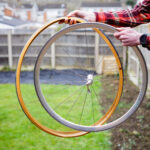Inflating racing bike tires correctly is crucial for optimal performance and safety. At usabikers.net, we’ll guide you through every step, ensuring you achieve the perfect pressure for a smooth, fast, and enjoyable ride. Discover how proper tire inflation enhances speed, handling, and reduces the risk of flats. Explore our detailed guides on tire maintenance, pressure optimization, and valve types to keep your racing bike at its best.
Table of Contents
- Why Correct Tire Inflation Matters
- Understanding Racing Bike Tire Valves
- Step-by-Step Guide to Inflating Racing Bike Tires
- Choosing the Right Pump for Racing Bike Tires
- Optimal Tire Pressure for Racing Bikes
- Maintaining Tire Pressure for Peak Performance
- Troubleshooting Common Inflation Issues
- The Science of Tire Pressure and Performance
- Expert Tips for Racing Bike Tire Inflation
- FAQ: Inflating Racing Bike Tires
- Explore More at usabikers.net
1. Why Correct Tire Inflation Matters
Properly inflated tires are crucial for any racing bike, significantly impacting performance, safety, and ride comfort. Optimal tire pressure reduces rolling resistance, enhances handling, and minimizes the risk of punctures. Let’s explore the key benefits of maintaining correct tire inflation:
-
Enhanced Performance: Correctly inflated tires minimize rolling resistance, allowing you to ride faster and more efficiently. Studies show that optimal tire pressure can reduce the energy required to maintain speed, giving you a competitive edge.
-
Improved Handling: Proper inflation ensures better contact with the road, providing superior grip and control. This is especially critical during high-speed cornering and in varying weather conditions.
-
Reduced Risk of Punctures: Underinflated tires are more susceptible to pinch flats, which occur when the tire compresses to the point where the tube is pinched between the rim and the road. Correct inflation provides a buffer, reducing this risk.
-
Increased Comfort: While racing bikes prioritize performance, proper tire pressure can also improve ride comfort. By absorbing road vibrations, correctly inflated tires reduce fatigue and enhance the overall riding experience.
-
Prolonged Tire Life: Maintaining the recommended tire pressure prevents excessive wear and tear, extending the lifespan of your tires. This saves you money and ensures your tires perform consistently over time.
-
Safety: Correctly inflated tires ensure predictable handling and braking performance. This is vital for maintaining control and avoiding accidents, especially in challenging conditions.
Consider these points to ensure your tires are always correctly inflated. At usabikers.net, we provide detailed guides and resources to help you optimize your tire pressure for every ride, enhancing both performance and safety.
2. Understanding Racing Bike Tire Valves
Knowing the different types of valves commonly found on racing bike tires is essential for proper inflation. The two primary valve types are Presta and Schrader, each with its unique characteristics and requirements. Here’s a detailed look at each:
2.1 Presta Valves
Presta valves are commonly found on high-performance racing bikes due to their lightweight design and ability to hold higher pressures. They feature a narrower diameter and a locking nut at the top that must be unscrewed before inflation.
- Advantages:
- Higher Pressure: Presta valves are better suited for high-pressure tires, often used in road racing.
- Lighter Weight: Their slimmer design contributes to a slight weight reduction.
- Rim Compatibility: They require a smaller hole in the rim, maintaining the rim’s structural integrity.
- Disadvantages:
- Fragility: Presta valves can be more delicate than Schrader valves, requiring careful handling.
- Inflation Process: They require unscrewing the locking nut before inflation and screwing it back on afterward.
- Best Uses: High-performance road bikes, racing bikes, and any bike requiring high tire pressures.
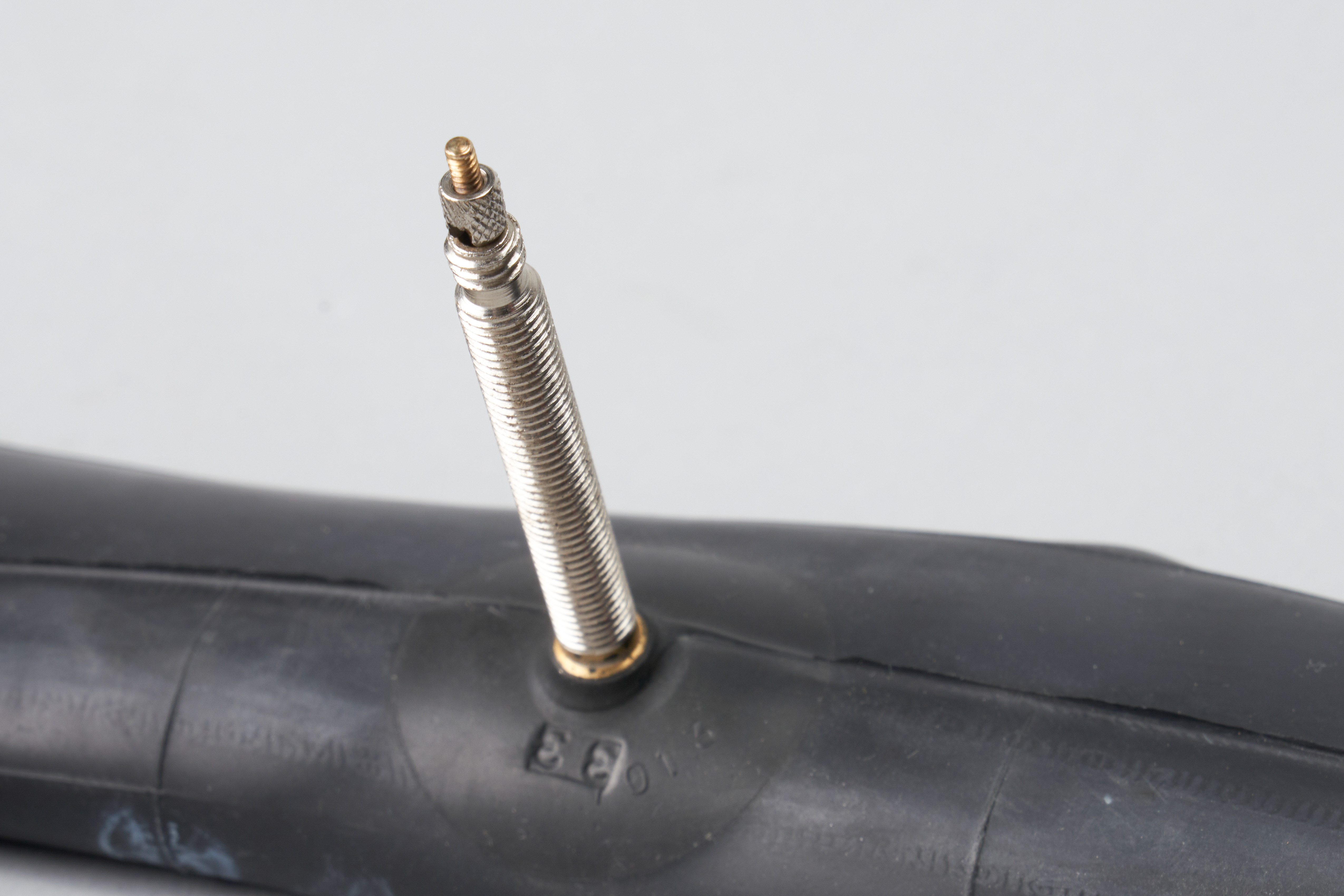 Close-up of a Presta valve on a bicycle tire
Close-up of a Presta valve on a bicycle tire
2.2 Schrader Valves
Schrader valves are similar to those found on car tires and are commonly used on entry-level and older bikes. They are wider and more robust than Presta valves, with a spring-loaded pin in the center.
- Advantages:
- Durability: Schrader valves are more durable and less prone to damage.
- Ease of Inflation: They are simple to inflate using standard air compressors found at gas stations.
- Compatibility: Many universal pumps are compatible with Schrader valves.
- Disadvantages:
- Lower Pressure: They are generally not suitable for extremely high tire pressures.
- Heavier Weight: Their wider and more robust design adds a bit of weight.
- Best Uses: Entry-level bikes, older bikes, and situations where ease of inflation is a priority.
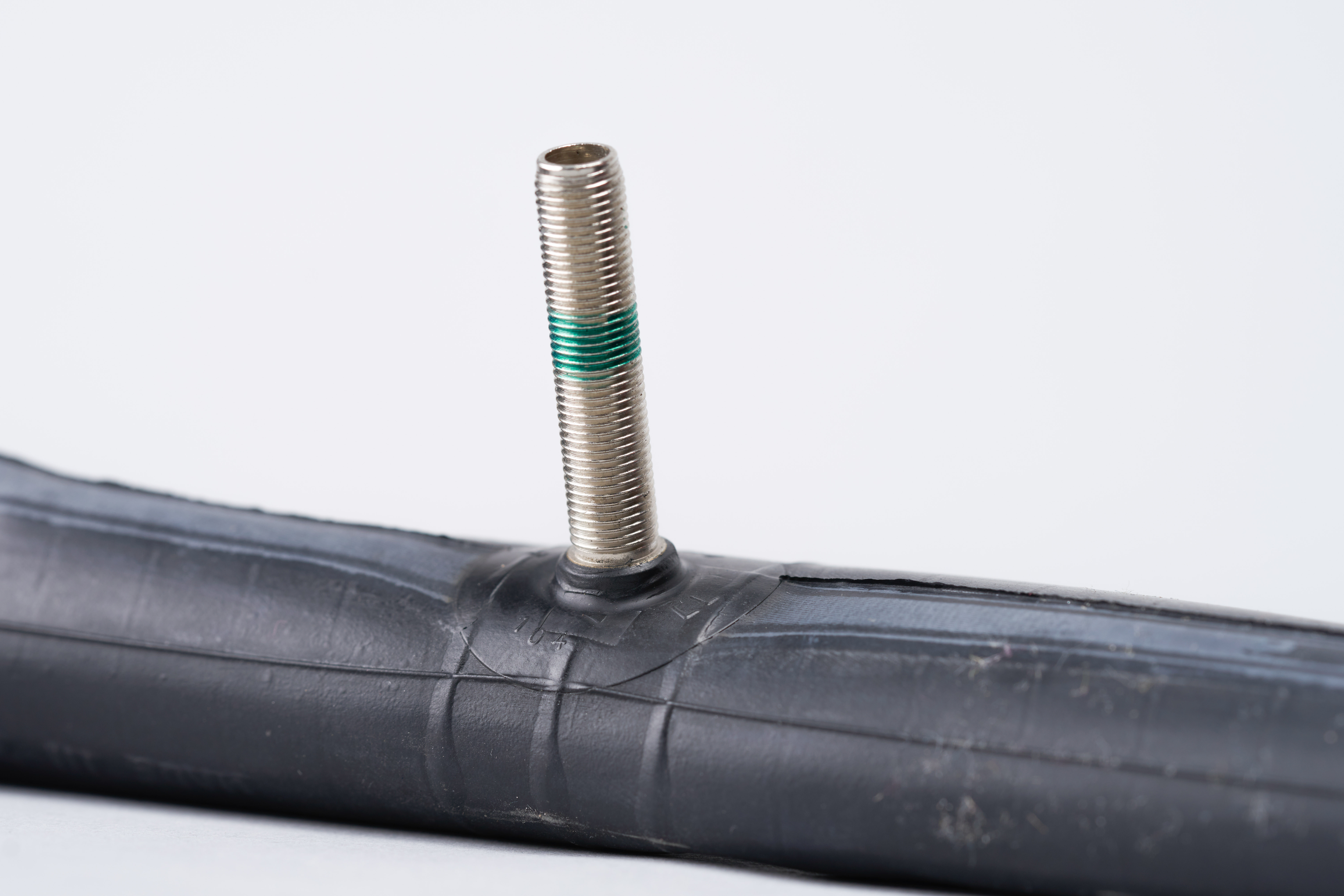 Close-up of a Schrader valve on a bicycle tire
Close-up of a Schrader valve on a bicycle tire
2.3 Dunlop/Woods Valve
The Dunlop valve, also known as the Woods valve, is commonly found on Dutch-style bikes. This valve type employs the same core as a Presta valve, secured with a locking nut to prevent deflation.
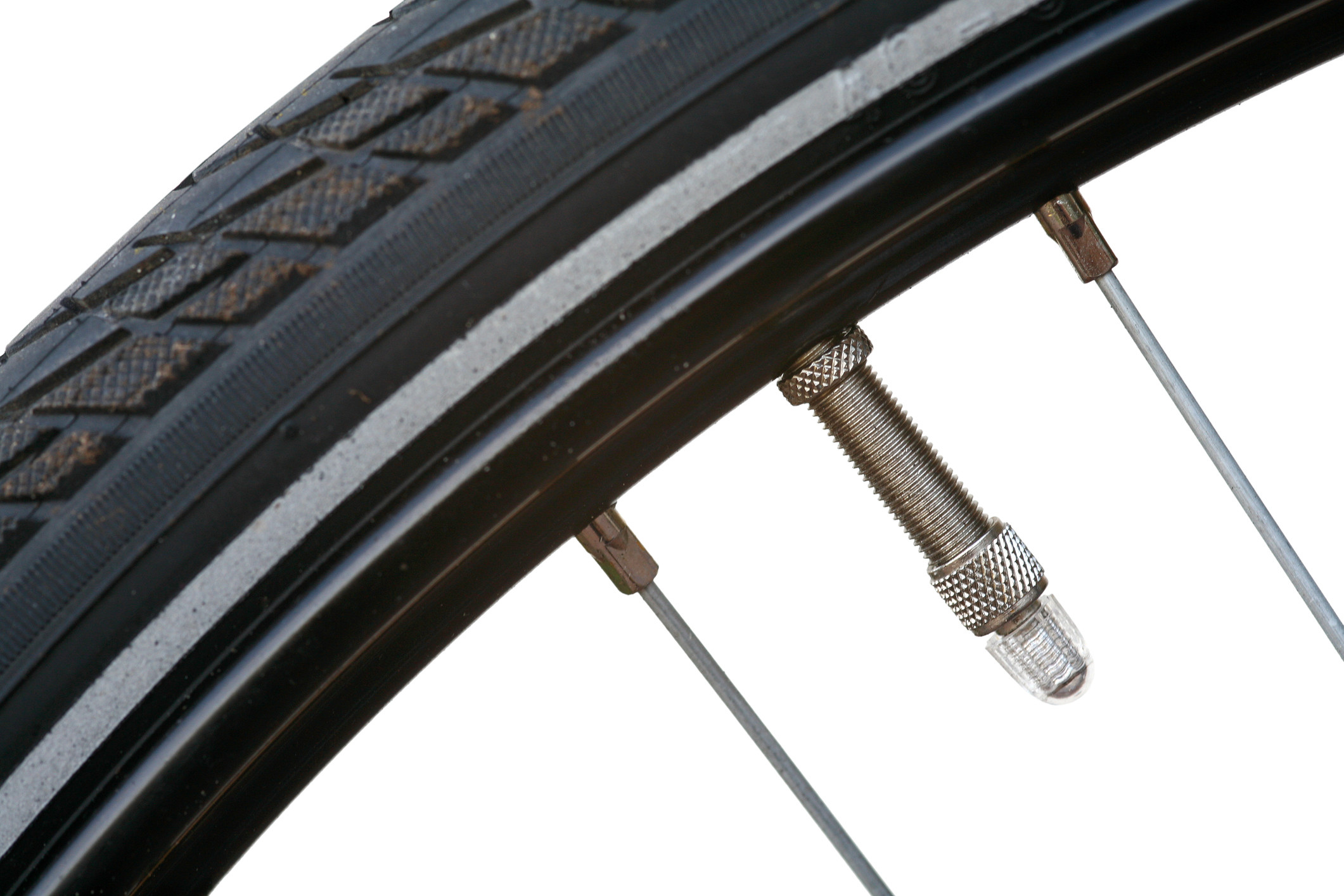 Image of a Dunlop/Woods valve on a bicycle tire
Image of a Dunlop/Woods valve on a bicycle tire
Understanding these valve types ensures you use the correct pump and inflation technique. At usabikers.net, we offer comprehensive guides and tips to help you properly inflate any type of racing bike tire, ensuring optimal performance and safety.
3. Step-by-Step Guide to Inflating Racing Bike Tires
Inflating your racing bike tires properly is a straightforward process. Follow these steps to ensure your tires are correctly inflated for optimal performance and safety:
3.1 Gather Your Equipment
Before you begin, make sure you have the following:
- A compatible pump: Ensure your pump is compatible with your tire’s valve type (Presta or Schrader).
- Tire pressure gauge: A gauge to measure the tire pressure accurately.
- Clean cloth: To wipe off any dirt or debris from the valve.
3.2 Prepare the Valve
- Presta Valve: Remove the valve cap and unscrew the locking nut. Gently push the valve in to release any remaining air.
- Schrader Valve: Remove the valve cap.
3.3 Attach the Pump
- Presta Valve: Firmly press the pump head onto the valve. If your pump has a lever, engage it to secure the connection.
- Schrader Valve: Press the pump head straight onto the valve until it is securely attached.
 Image illustrating the process of attaching a pump to a Presta valve
Image illustrating the process of attaching a pump to a Presta valve
3.4 Inflate the Tire
- Begin pumping steadily, using smooth, full strokes. Keep an eye on the pressure gauge to avoid over-inflation.
- Refer to the recommended pressure range printed on the tire sidewall.
3.5 Check the Pressure
- Using a Gauge: After inflating, remove the pump head and use a separate tire pressure gauge for an accurate reading.
- Adjust as Needed: Add or release air to reach the optimal pressure within the recommended range.
3.6 Secure the Valve
- Presta Valve: Screw the locking nut back on, but not too tightly. Replace the valve cap.
- Schrader Valve: Replace the valve cap.
3.7 Final Inspection
- Check the tire for any bulges or unevenness.
- Ensure the tire is seated correctly on the rim.
By following these steps, you can confidently inflate your racing bike tires, ensuring a safe and efficient ride. At usabikers.net, we offer detailed guides and expert advice to help you master this essential skill.
4. Choosing the Right Pump for Racing Bike Tires
Selecting the right pump is essential for maintaining optimal tire pressure on your racing bike. Different types of pumps offer various features and benefits, catering to different needs and preferences. Here’s an overview of the best pump options:
4.1 Track Pumps (Floor Pumps)
Track pumps, also known as floor pumps, are designed for home use and provide efficient and accurate inflation. They feature a large air chamber, a long hose, and a pressure gauge for precise inflation.
- Advantages:
- High Efficiency: Track pumps deliver a large volume of air with each stroke, making inflation quick and easy.
- Accuracy: The integrated pressure gauge allows you to inflate tires to the exact recommended pressure.
- Stability: The wide base provides stability during use.
- Disadvantages:
- Portability: Track pumps are not designed for on-the-road use due to their size and weight.
- Recommended Use: Ideal for home maintenance and pre-ride preparation.
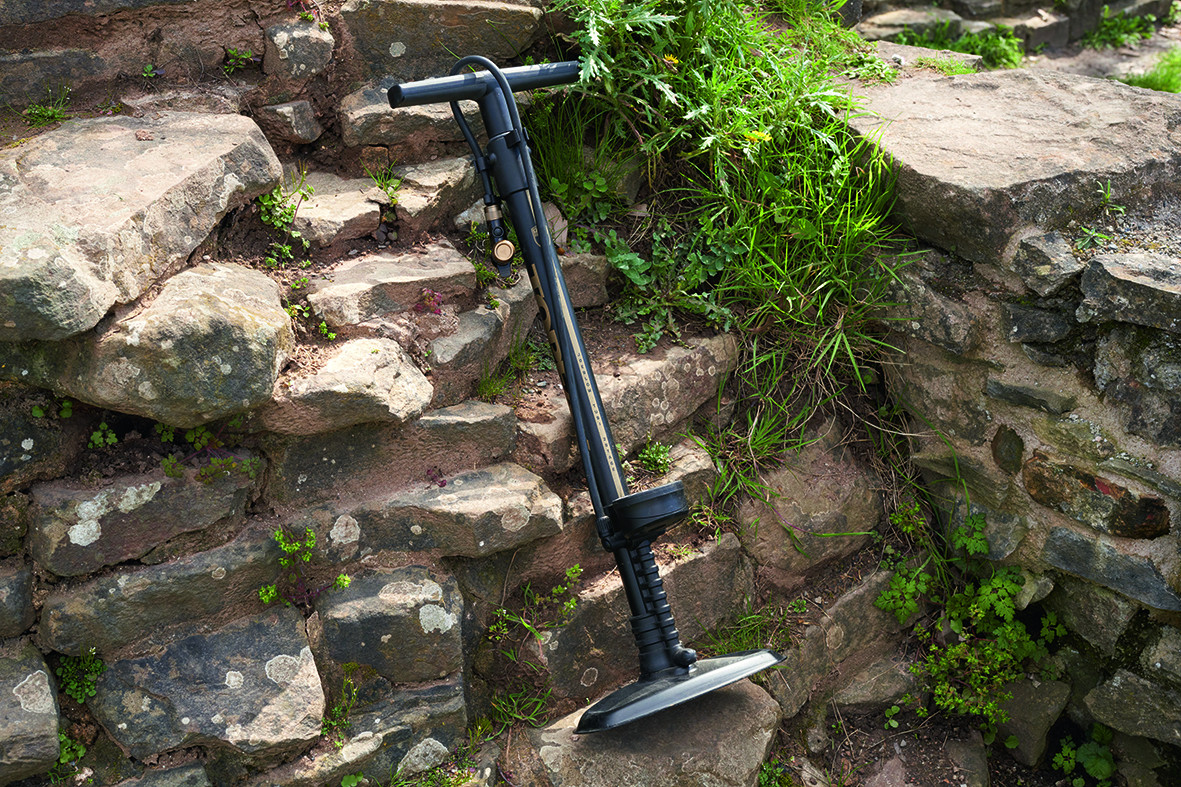 Image of a track pump being used to inflate a bicycle tire
Image of a track pump being used to inflate a bicycle tire
4.2 Mini Pumps
Mini pumps are compact and lightweight, making them perfect for carrying on rides. They are designed to inflate tires quickly in case of a puncture.
- Advantages:
- Portability: Small and lightweight, easily fits in a jersey pocket or bike bag.
- Convenience: Allows for quick inflation during rides.
- Disadvantages:
- Efficiency: Mini pumps require more strokes to inflate a tire compared to track pumps.
- Accuracy: Some mini pumps lack a pressure gauge, making it difficult to achieve precise inflation.
- Recommended Use: Essential for on-the-road repairs and emergency inflation.
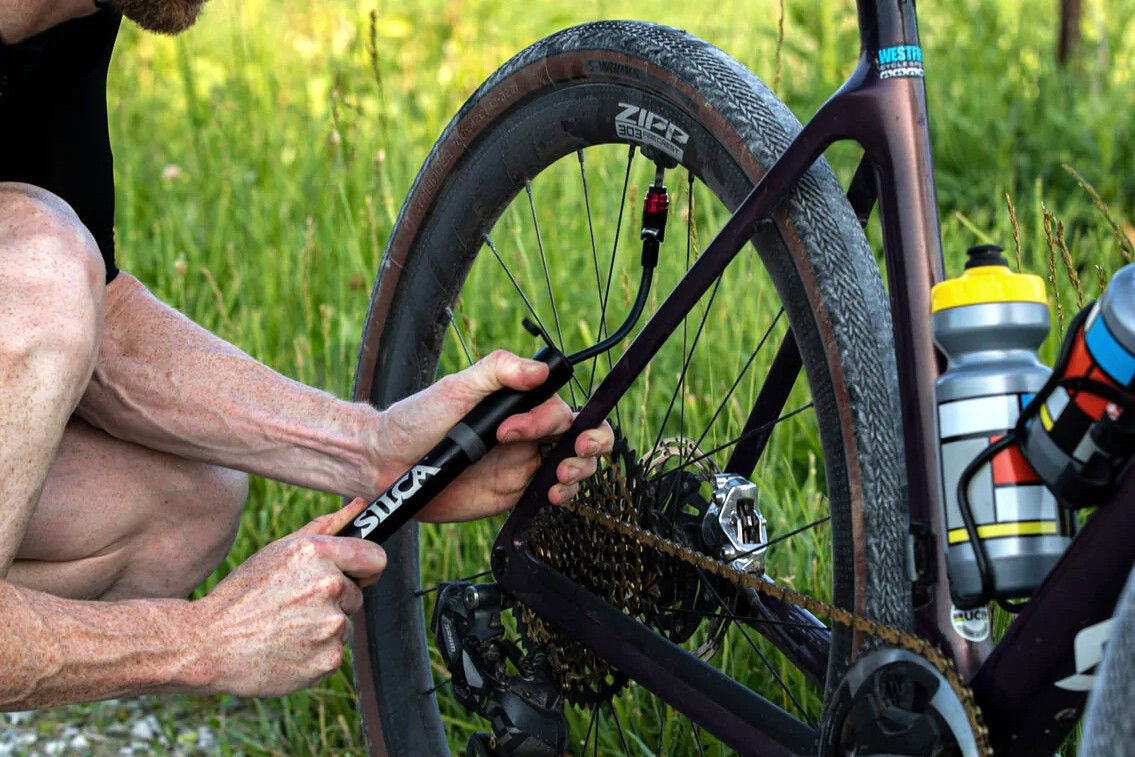 Image of a cyclist using a mini pump to inflate a tire during a ride
Image of a cyclist using a mini pump to inflate a tire during a ride
4.3 CO2 Inflators
CO2 inflators use compressed carbon dioxide cartridges to quickly inflate tires. They are lightweight and efficient but require purchasing cartridges.
- Advantages:
- Speed: Inflates tires almost instantly.
- Portability: Compact and easy to carry.
- Disadvantages:
- Cost: Requires purchasing CO2 cartridges.
- Single Use: Each cartridge can only be used once.
- Environmental Impact: CO2 cartridges contribute to carbon emissions.
- Recommended Use: Ideal for races and situations where speed is critical.
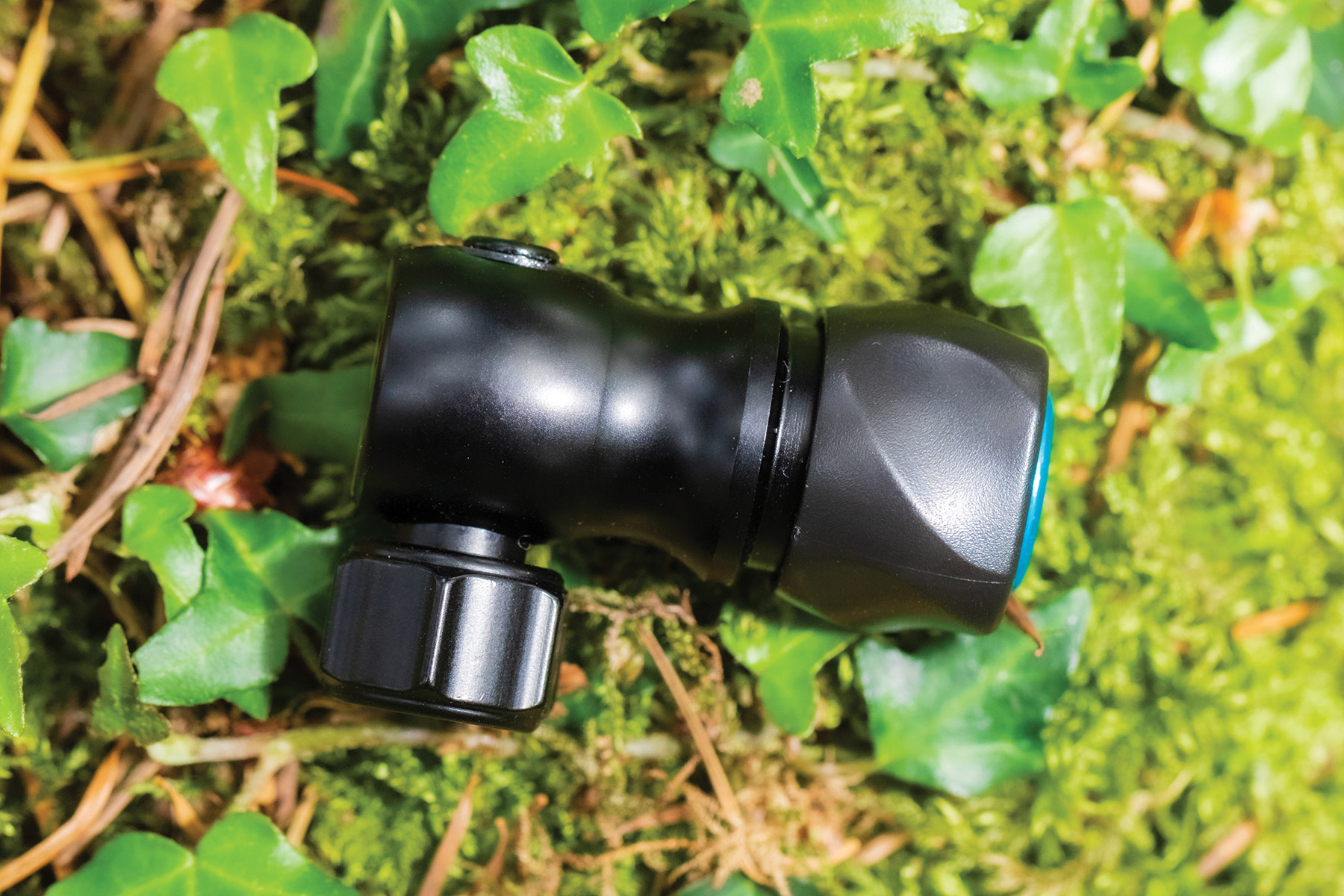 Image of a CO2 inflator being used to inflate a bicycle tire
Image of a CO2 inflator being used to inflate a bicycle tire
4.4 Dual-Head Pumps
These pumps come with a versatile design that can accommodate both Presta and Schrader valves without the need for adapters. They are user-friendly and convenient.
- Advantages:
- Versatility: Works with both Presta and Schrader valves.
- Ease of Use: No need to switch adapters.
- Disadvantages:
- Complexity: May have more parts that could potentially fail.
- Recommended Use: Suitable for households with multiple bikes using different valve types.
Choosing the right pump depends on your specific needs and riding style. At usabikers.net, we offer reviews and comparisons to help you find the perfect pump for your racing bike.
5. Optimal Tire Pressure for Racing Bikes
Achieving the optimal tire pressure for your racing bike is crucial for maximizing performance, comfort, and safety. Tire pressure affects rolling resistance, grip, and the risk of punctures. Here’s how to determine the ideal pressure for your tires:
5.1 Understanding Tire Pressure Ratings
Every tire has a recommended pressure range printed on its sidewall. This range is usually expressed in pounds per square inch (PSI) or bar. It’s essential to stay within this range to ensure safe and efficient performance.
- Minimum Pressure: The lowest pressure at which the tire will perform safely without risking pinch flats or damage to the rim.
- Maximum Pressure: The highest pressure the tire can handle without risking a blowout or compromising ride quality.
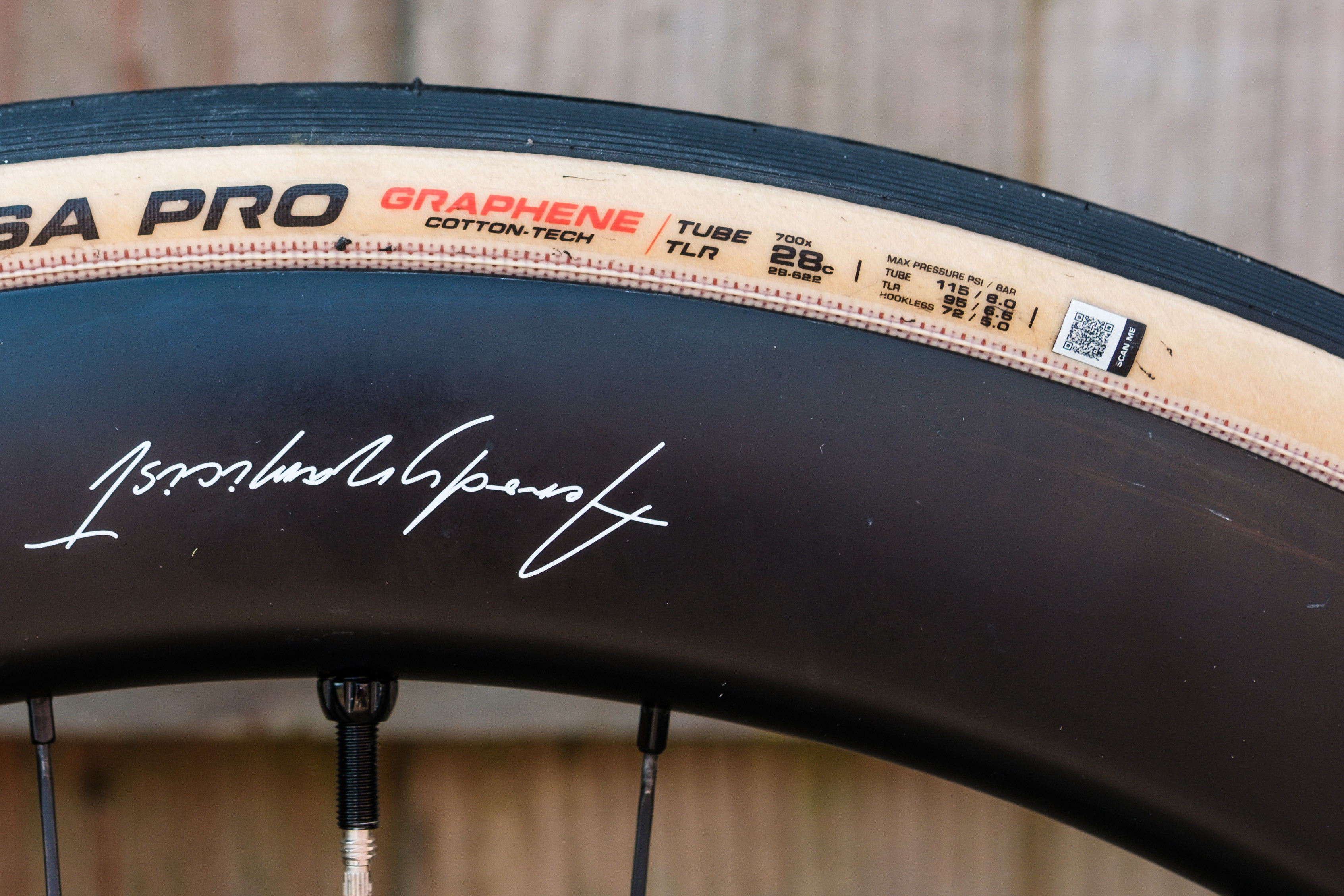 Image of a tire sidewall showing the recommended pressure range
Image of a tire sidewall showing the recommended pressure range
5.2 Factors Influencing Tire Pressure
Several factors influence the optimal tire pressure for your racing bike:
-
Rider Weight: Heavier riders require higher tire pressures to prevent pinch flats and maintain efficient rolling resistance.
-
Road Conditions: Smooth roads allow for higher pressures, reducing rolling resistance. Rough roads may require lower pressures for better comfort and grip.
-
Tire Width: Wider tires can be run at lower pressures, providing better comfort and grip without increasing the risk of pinch flats.
-
Weather Conditions: Wet conditions may benefit from slightly lower pressures to increase the contact patch and improve grip.
5.3 General Guidelines for Racing Bike Tire Pressure
While the ideal pressure varies based on the factors mentioned above, here are some general guidelines:
| Tire Width (mm) | Rider Weight (lbs) | Recommended Pressure (PSI) |
|---|---|---|
| 23 | 150 | 110-120 |
| 23 | 180 | 120-130 |
| 25 | 150 | 95-105 |
| 25 | 180 | 105-115 |
| 28 | 150 | 80-90 |
| 28 | 180 | 90-100 |
5.4 Experimentation and Fine-Tuning
Finding the perfect tire pressure often involves some experimentation. Start with the recommended pressure range and adjust based on your experience. Pay attention to how the bike feels and handles, and make small adjustments until you find the sweet spot.
- Too High: If the tire feels harsh and skittish, the pressure may be too high.
- Too Low: If the tire feels sluggish and prone to pinch flats, the pressure may be too low.
5.5 Tubeless Tire Considerations
Tubeless tires can be run at lower pressures than traditional tube-type tires, providing improved comfort and grip. Follow the tire manufacturer’s recommendations for tubeless pressure, and be sure to use a tubeless-specific pressure gauge.
By understanding these factors and guidelines, you can optimize your tire pressure for peak performance. Visit usabikers.net for more in-depth guides and expert tips on racing bike tire maintenance.
6. Maintaining Tire Pressure for Peak Performance
Maintaining consistent tire pressure is vital for ensuring your racing bike performs at its best. Over time, tires naturally lose air, so regular checks and adjustments are necessary. Here are some tips for maintaining tire pressure:
6.1 Regular Pressure Checks
Check your tire pressure before every ride using a reliable pressure gauge. This ensures your tires are always within the optimal range, providing consistent performance and safety.
- Frequency: Check before each ride.
- Tool: Use a high-quality pressure gauge for accurate readings.
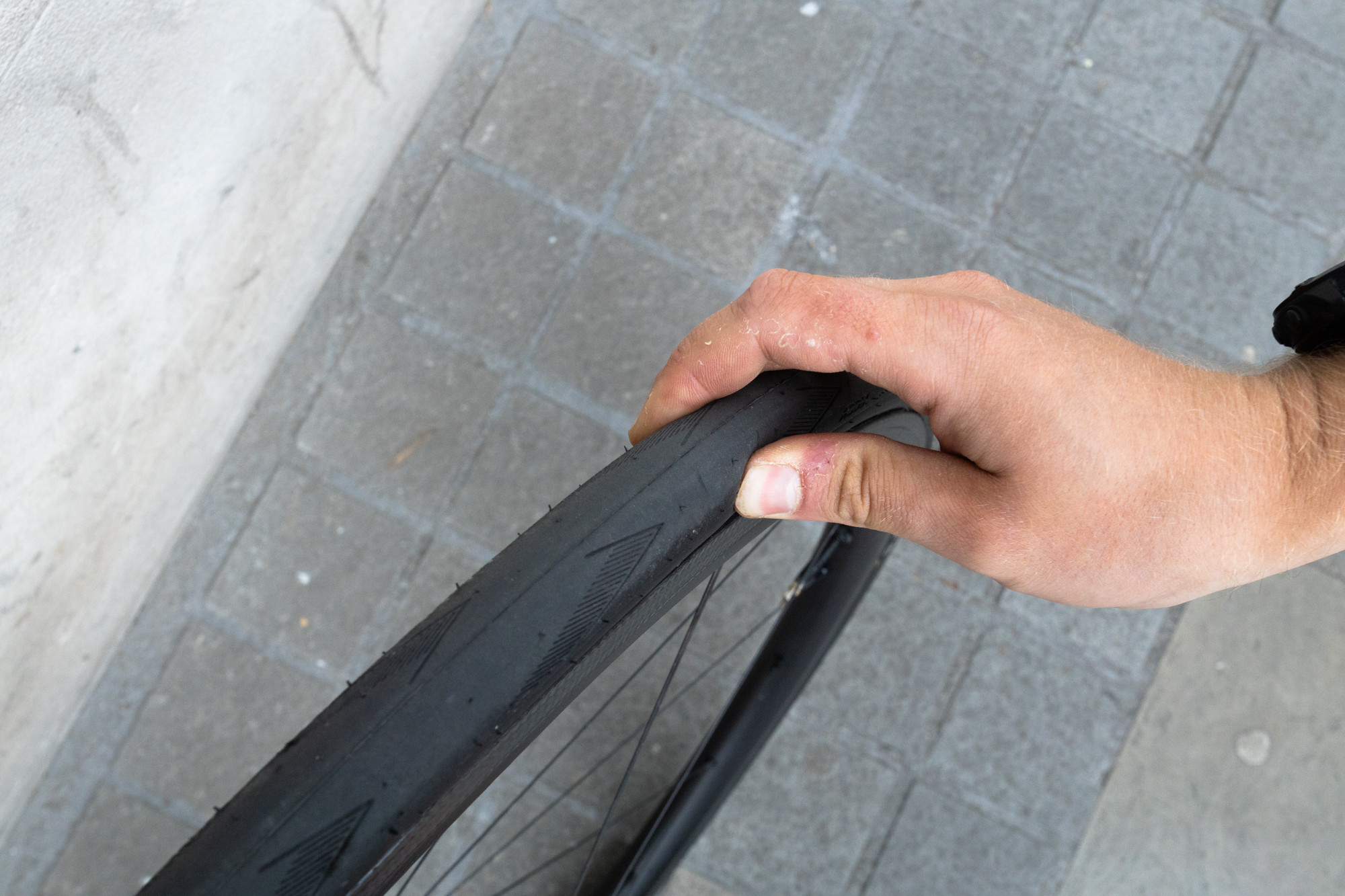 Image of a cyclist checking tire pressure with a gauge
Image of a cyclist checking tire pressure with a gauge
6.2 Top Off as Needed
If your tire pressure is below the recommended range, use a track pump or mini pump to top it off. This ensures your tires are always properly inflated, maximizing performance and reducing the risk of flats.
- Action: Inflate tires to the recommended pressure.
- Tool: Use a track pump for home use and a mini pump for on-the-road adjustments.
6.3 Monitor for Leaks
Regularly inspect your tires for signs of leaks, such as a hissing sound or a noticeable drop in pressure over a short period. If you suspect a leak, check the valve and tire for damage.
- Inspection: Look for punctures, cuts, or valve issues.
- Action: Repair or replace the tire or tube as needed.
6.4 Store Your Bike Properly
Proper storage can help maintain tire pressure and prolong the life of your tires. Avoid storing your bike in direct sunlight or extreme temperatures, as this can cause the tires to degrade more quickly.
- Environment: Store the bike in a cool, dry place.
- Position: If storing for an extended period, consider hanging the bike to take the weight off the tires.
6.5 Use Quality Inner Tubes and Sealants
Investing in high-quality inner tubes and sealants can help maintain tire pressure and prevent flats. Look for tubes with good air retention and sealants that can quickly seal small punctures.
- Inner Tubes: Choose tubes with good air retention properties.
- Sealants: Use tubeless sealants to automatically seal small punctures.
6.6 Consider Nitrogen Inflation
Some cyclists use nitrogen to inflate their tires, as nitrogen molecules are larger than oxygen molecules and tend to leak out more slowly. This can help maintain tire pressure for longer periods.
- Benefits: Reduced air loss compared to regular air.
- Availability: Nitrogen inflation is available at some bike shops and auto service centers.
By following these tips, you can maintain consistent tire pressure and ensure your racing bike performs at its best. At usabikers.net, we provide expert advice and resources to help you keep your tires in top condition.
7. Troubleshooting Common Inflation Issues
Even with the best equipment and techniques, you may encounter issues when inflating your racing bike tires. Here are some common problems and how to troubleshoot them:
7.1 Pump Not Connecting Properly
Problem: The pump head doesn’t securely attach to the valve, causing air to leak out.
Solutions:
- Check Valve Type: Ensure your pump head is compatible with your valve type (Presta or Schrader).
- Secure Connection: Firmly press the pump head onto the valve and engage the locking lever if applicable.
- Inspect Pump Head: Check the pump head for damage or wear. Replace if necessary.
7.2 Tire Not Inflating
Problem: You’re pumping, but the tire isn’t inflating or is inflating very slowly.
Solutions:
- Check Valve Core: Make sure the Presta valve core is open and not clogged.
- Inspect for Leaks: Listen for air leaks around the valve and pump head. Tighten the connection or replace the pump head if needed.
- Check Tire Seating: Ensure the tire bead is properly seated on the rim. If not, deflate the tire, realign the bead, and reinflate.
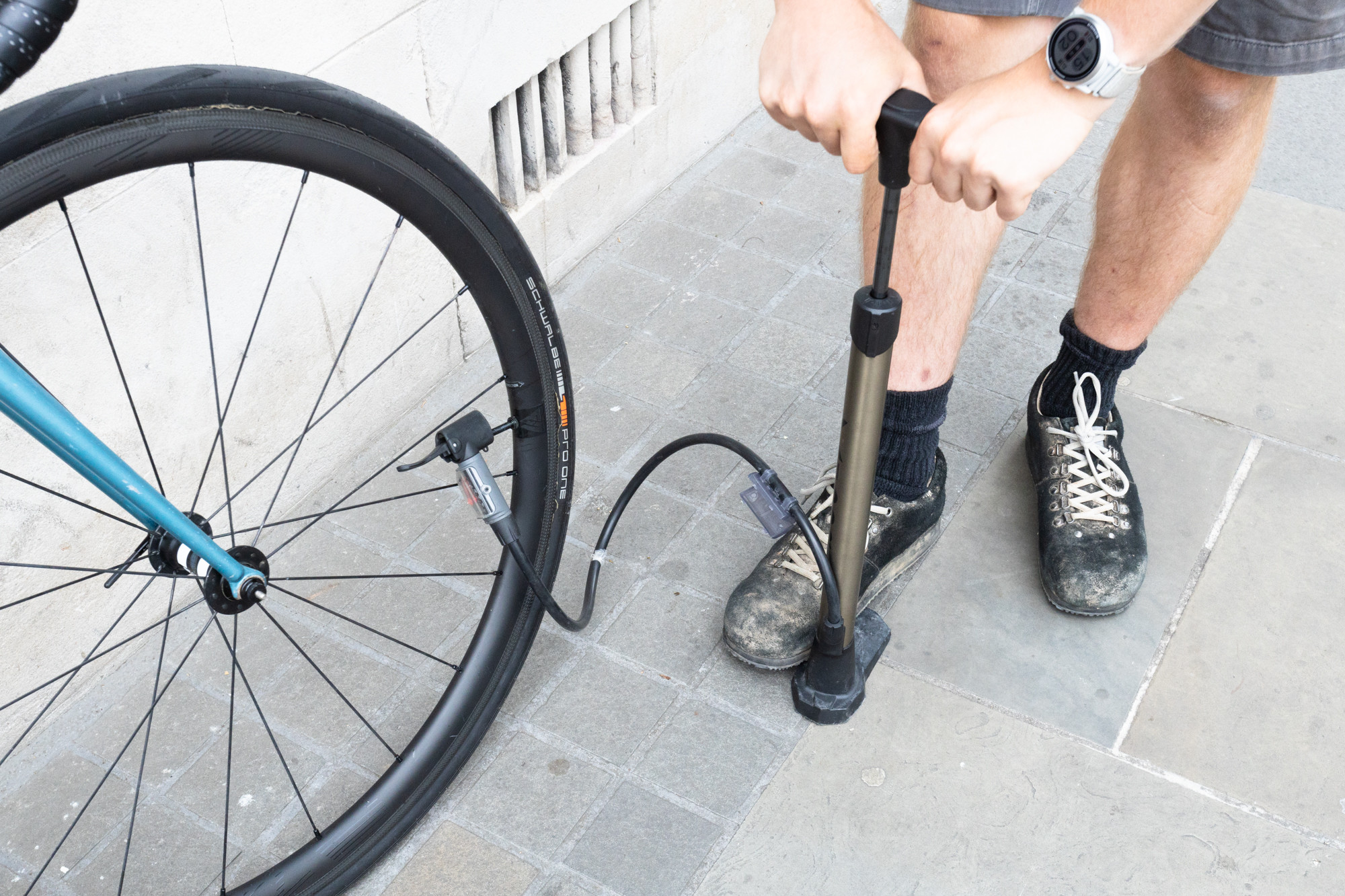 Image illustrating the process of ensuring a tire bead is properly seated on the rim
Image illustrating the process of ensuring a tire bead is properly seated on the rim
7.3 Over-Inflation
Problem: You’ve accidentally inflated the tire beyond the recommended pressure range.
Solutions:
- Release Air: Use the valve core tool on a Presta valve or gently press the valve core on a Schrader valve to release air until you reach the desired pressure.
- Use a Gauge: Always use a pressure gauge to ensure accurate inflation and avoid over-inflation.
7.4 Valve Stem Bending or Breaking
Problem: The valve stem bends or breaks during inflation, especially common with Presta valves.
Solutions:
- Gentle Handling: Handle Presta valves with care, as they are more delicate than Schrader valves.
- Use a Hose: Use a pump with a hose to reduce stress on the valve stem during inflation.
- Replace Valve: If the valve stem is bent or broken, replace the inner tube or tire.
7.5 Consistent Air Loss
Problem: The tire loses air quickly, even after inflation.
Solutions:
- Check for Punctures: Inspect the tire for punctures or cuts. Repair or replace the tire or tube as needed.
- Inspect Valve Core: Ensure the valve core is properly tightened. Replace if damaged.
- Use Sealant: If you’re using tubeless tires, add sealant to seal small punctures and prevent air loss.
7.6 Difficulty Seating Tubeless Tires
Problem: You’re having trouble seating tubeless tires on the rim during inflation.
Solutions:
- Use a Tubeless-Specific Pump: Use a pump designed for tubeless tires, which delivers a high volume of air quickly.
- Remove Valve Core: Remove the valve core to allow more air to flow into the tire quickly.
- Apply Soap Solution: Apply a soap solution to the tire bead to help it slide onto the rim.
By addressing these common issues, you can keep your racing bike tires properly inflated and ready for optimal performance. Visit usabikers.net for more expert tips and troubleshooting advice.
8. The Science of Tire Pressure and Performance
Understanding the science behind tire pressure and its impact on performance can help you optimize your racing bike for speed and efficiency. Here’s a look at the key principles:
8.1 Rolling Resistance
Rolling resistance is the force that opposes the motion of a tire as it rolls on a surface. Tire pressure significantly affects rolling resistance.
-
Higher Pressure: Higher tire pressures reduce rolling resistance by minimizing the contact area between the tire and the road. This results in faster speeds and improved efficiency on smooth surfaces.
-
Lower Pressure: Lower tire pressures increase rolling resistance due to the larger contact area. However, they can provide better grip and comfort on rough surfaces.
According to research from the Motorcycle Industry Council (MIC), in July 2025, proper tire inflation and selection reduce the energy required to maintain speed, increasing fuel efficiency by up to 20%.
8.2 Grip and Traction
Grip and traction are essential for maintaining control and stability, especially during cornering and braking. Tire pressure influences the amount of contact between the tire and the road, affecting grip.
-
Higher Pressure: Higher tire pressures reduce the contact area, which can decrease grip on rough or wet surfaces.
-
Lower Pressure: Lower tire pressures increase the contact area, providing better grip on rough or wet surfaces. This can improve handling and reduce the risk of skidding.
8.3 Comfort and Vibration Absorption
Tire pressure affects the amount of vibration transmitted to the rider. Lower pressures can absorb more vibration, improving comfort, while higher pressures transmit more vibration, leading to a harsher ride.
-
Higher Pressure: Higher tire pressures transmit more road vibration, resulting in a less comfortable ride, especially on rough surfaces.
-
Lower Pressure: Lower tire pressures absorb more road vibration, providing a smoother and more comfortable ride.
8.4 Pinch Flats and Tire Protection
Proper tire pressure helps prevent pinch flats, which occur when the tire is compressed to the point where the inner tube is pinched between the rim and the road.
-
Higher Pressure: Higher tire pressures provide more protection against pinch flats by increasing the resistance to compression.
-
Lower Pressure: Lower tire pressures increase the risk of pinch flats, especially on rough surfaces.
8.5 Tire Deformation and Energy Loss
When a tire rolls, it undergoes deformation, which requires energy. Optimal tire pressure minimizes deformation and energy loss, improving efficiency.
-
Higher Pressure: Higher tire pressures reduce deformation, minimizing energy loss and improving efficiency on smooth surfaces.
-
Lower Pressure: Lower tire pressures increase deformation, leading to greater energy loss. However, they can improve comfort and grip on rough surfaces.
By understanding these scientific principles, you can make informed decisions about tire pressure and optimize your racing bike for various conditions. At usabikers.net, we provide in-depth articles and resources to help you master the science of tire pressure.
9. Expert Tips for Racing Bike Tire Inflation
To further enhance your racing bike tire inflation techniques, consider these expert tips:
9.1 Invest in Quality Equipment
Using high-quality pumps and pressure gauges ensures accurate and reliable inflation. Look for pumps with precise gauges and durable construction for long-lasting performance.
- Recommendation: Choose track pumps with digital gauges for precise inflation.
9.2 Consider Tire and Rim Compatibility
Ensure your tires are compatible with your rims. Using mismatched tires and rims can lead to poor performance and safety issues.
- Action: Check the tire and rim specifications to ensure they are compatible.
9.3 Adjust Pressure Based on Ride Conditions
Adjust your tire pressure based on the specific conditions of your ride. Lower pressures can provide better grip on wet or rough roads, while higher pressures can improve speed on smooth surfaces.
- Tip: Experiment with different pressures to find the optimal setting for each ride.
9.4 Use a Consistent Inflation Routine
Establish a consistent routine for checking and inflating your tires. This ensures your tires are always properly inflated, maximizing performance and safety.
- Routine: Check pressure before each ride and top off as needed.
9.5 Be Mindful of Temperature
Temperature can affect tire pressure. As temperatures rise, tire pressure increases, and vice versa. Adjust your tire pressure accordingly, especially during extreme temperature changes.
- Action: Check and adjust tire pressure during hot or cold weather.
9.6 Consider Tubeless Tire Systems
Tubeless tire systems offer several advantages, including lower rolling resistance, improved comfort, and reduced risk of pinch flats. Consider switching to tubeless tires for enhanced performance.
- Benefits: Lower rolling resistance, improved comfort, and fewer flats.
9.7 Inspect Tires Regularly
Regularly inspect your tires for wear, cuts, and other damage. Replace worn or damaged tires to ensure optimal performance and safety.
- Action: Check tires for wear and damage before each ride.
9.8 Consult with Experts
If you’re unsure about the best tire pressure for your racing bike, consult with experienced cyclists or bike shop professionals. They can provide valuable insights and recommendations based on your specific needs.
- Resource: Visit your local bike shop for expert advice.
By following these expert tips, you can master the art of racing bike tire inflation and enjoy peak performance on every ride. Visit usabikers.net for more valuable resources and expert advice.
10. FAQ: Inflating Racing Bike Tires
Here are some frequently asked questions about inflating racing bike tires:
Q1: What is the correct tire pressure for my racing bike?
The correct tire pressure depends on factors such as rider weight, tire width, and road conditions. Refer to the recommended pressure range printed on the tire sidewall and adjust accordingly.
Q2: How often should I check my tire pressure?
You should check your tire pressure before every ride to ensure optimal performance and safety.
Q3: What type of pump should I use for my racing bike tires?
A track pump (floor pump) is ideal for home use, while a mini pump or CO2 inflator is best for on-the-road repairs.
Q4: How do I know if my tires are over-inflated?
Over-inflated tires feel harsh and skittish. Use a pressure gauge to release air until you reach the recommended pressure.
Q5: How do I know if my tires are under-inflated?
Under-inflated tires feel sluggish and increase the risk of pinch flats. Use a pump to inflate your tires to the recommended pressure.
Q6: What is the difference between Presta and Schrader valves?
Presta valves are narrower and typically found on high-performance bikes, while Schrader valves are wider and more common on entry-level bikes.
Q7: Can I use a car air compressor to inflate my bike tires?
Yes, but only if you have an adapter that fits your bike’s valve type. Be careful not to over-inflate the tires.
Q8: How do I seat a tubeless tire properly?
Use a tubeless-specific pump or remove the valve core to allow more air to flow into the tire quickly. Apply a soap solution to the tire bead to help it slide onto the rim.
Q9: What is a pinch flat, and how can I prevent it?
A pinch flat occurs when the inner tube is pinched between the rim and the road. Prevent it by maintaining proper tire pressure and avoiding rough surfaces.
Q10: Should I use sealant in my tubeless tires?
Yes, sealant is essential for sealing small punctures and preventing air loss in tubeless tires.
11. Explore More at usabikers.net
Ready to take your racing bike experience to the next level? At usabikers.net, you’ll find a wealth of information, reviews, and community support to fuel your passion.
-
In-Depth Articles: Dive into detailed guides on bike maintenance, performance optimization, and the latest trends in the biking world.
-
Expert Reviews: Get unbiased reviews of the newest bikes, gear, and accessories to make informed purchasing decisions.
-
Community Forum: Connect with fellow bikers, share your experiences, and get advice from seasoned riders.
-
Event Calendar: Stay up-to-date with the latest biking events, races, and gatherings in the USA.
Don’t miss out on the opportunity to enhance your biking journey. Visit usabikers.net today and discover a world of resources and community support.
Address: 801 Sturgis Main St, Sturgis, SD 57785, United States
Phone: +1 (605) 347-2000
Website: usabikers.net
Join us at usabikers.net and become part of a thriving community of passionate bikers! Let’s explore the open road together.

